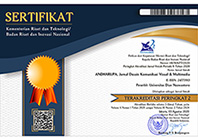Studi Semiotika Karakter Monokuma pada Anime Franchise Series "Danganronpa"
Abstract
Abstrak
Penelitian ini dibuat untuk membahas tentang tokoh utama dalam salah satu anime franchise series yang laris yaitu Danganronpa. Danganronpa menceritakan kisah tentang beberapa pelajar yang terjebak di sekolah. Untuk bisa keluar dari sekolah tersebut mereka harus membunuh tanpa ketahuan. Dalam Danganronpa, tokoh yang menjadi pusat penelitian disini adalah karakter Monokuma. Monokuma merupakan kepala sekolah disana yang berwujud beruang. Studi ini membahas tentang studi desain karakter dalam perannya pada sebuah cerita. Teori yang digunakan untuk membedah ini adalah teori semiotika dimana akan dianalisis tentang elemen-elemen pembentuk desain karakter Monokuma dan peran yang ditunjukkan. Studi ini membahas bagaimana perkembangan dunia visual dalam menciptakan pemaknaan pada benak penonton.
Kata kunci: anime, Danganronpa, desain karakter, Monokuma, semiotika
Abstract
This research was made to discuss the main character in one of the best-selling anime franchise series, Danganronpa. Danganronpa tells the story of some students trapped in the school. To be able to get out of school they have to kill without getting caught. In Danganronpa, the character who is the center of research here is the character of Monokuma. Monokuma is the headmaster of the school in the form of a bear. This study discusses the study of character design in its role in a story. The theory used to study this problem is Semiotics theory which will be analyzed about the elements forming the design of the Monokuma character and the roles are shown. This study discusses how the development of the visual world in creating meaning in the mind of the audience.
Keywords: anime, character design, Danganronpa, Monokuma, semiotics
Full Text:
PDFReferences
Animal : Bear. (n.d.). Retrieved Agustus 20, 2018, from https://onekindplanet.org
Barthes, R. (1968). Elements of Semiology. New York.
Chandler, D. (2007). Semiotics : The Basic. London: Routledge.
Danganronpa Wikia. (n.d.). Retrieved Agustus 10, 2018, from http://danganronpa.wikia.com
Debord, G. (1994). The Society of The Spectacle. New York: Zone Books.
Eisenbeis, R. (2013). Danganronpa: The Animation Makes a Mess of a Great Game.
Ito, M., Okabe, D., & Tsuji, I. (2005). Fandom Unbound. London: Yale University Press.
Lamerichs, N. (2013). The cultural dynamic of doujinshi and cosplay: Local anime fandom in Japan, USA and Europe. Journal of Reception and Audience Studies, 154-177.
Littlejohn, S. W. (2009). Theories of Human Communication. Jakarta: Salemba Humanika.
Nye, J. J. (2004). Soft Power : The Means to Success in World Politics. New York: Public Affairs.
Piliang, Y. A. (2003). Hipersemiotika : Tafsir Cultural Studies Atas Matinya Makna. Bandung: Jalasutra.
Ritzer, G. (2012). Teori Sosiologi. Yogyakarta: Pustaka Pelajar.
DOI: https://doi.org/10.33633/andharupa.v5i01.2152
Article Metrics
Abstract view : 1571 timesPDF - 1122 times
Refbacks
indexed by:
Andharupa Journal (p-ISSN: 2477 - 2852 | e-ISSN: 2477 - 3913) is published by Dian Nuswantoro University, Semarang. This Journal is licensed under Creative Commons Attribution 4.0 International License.
























